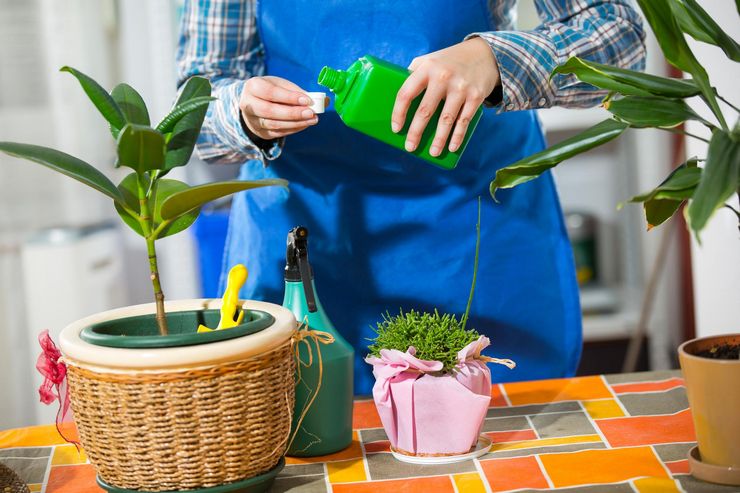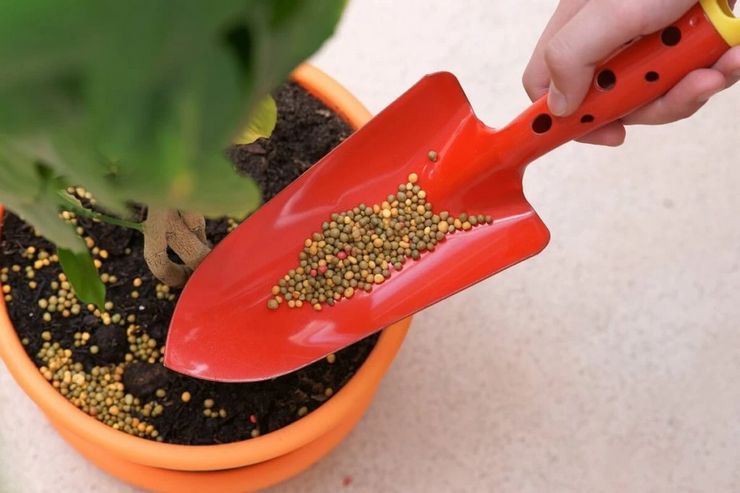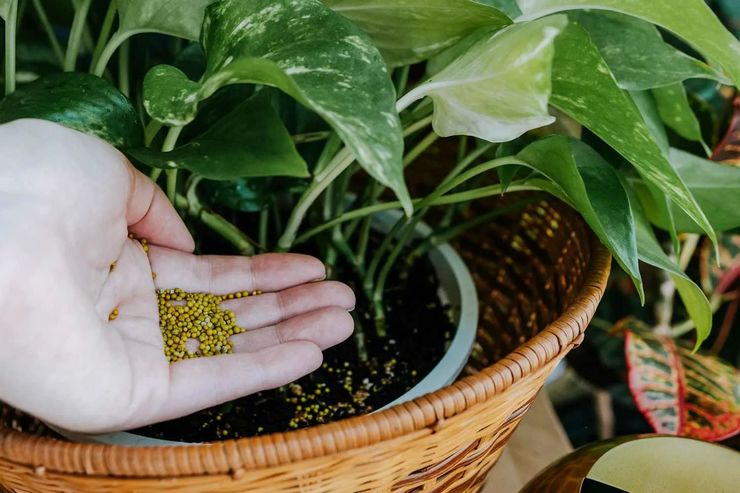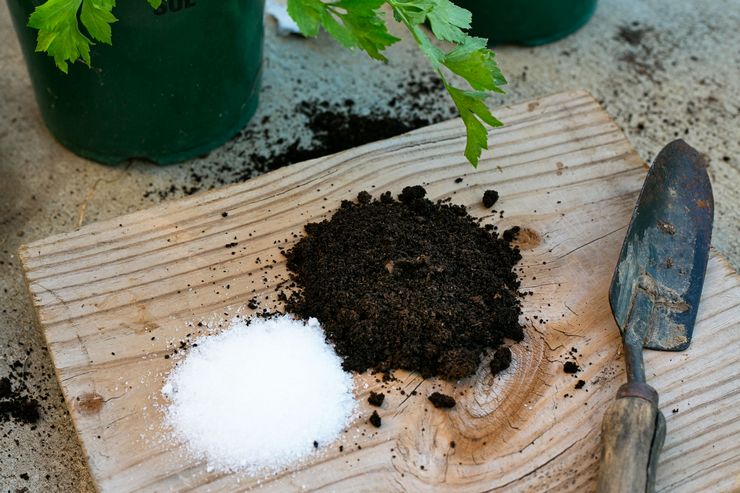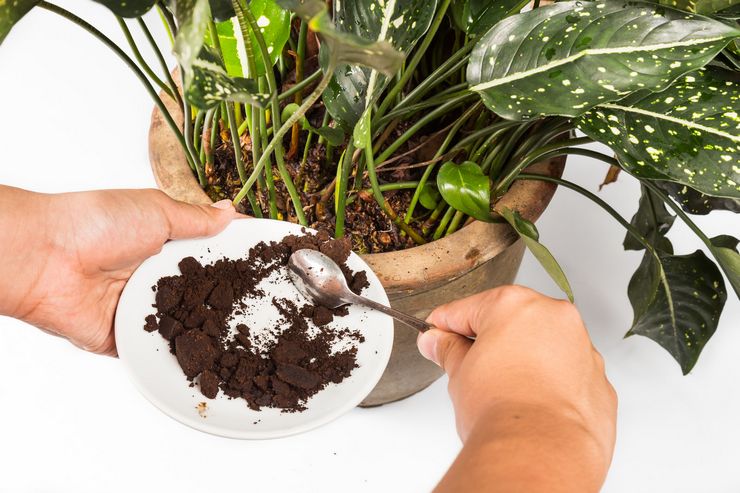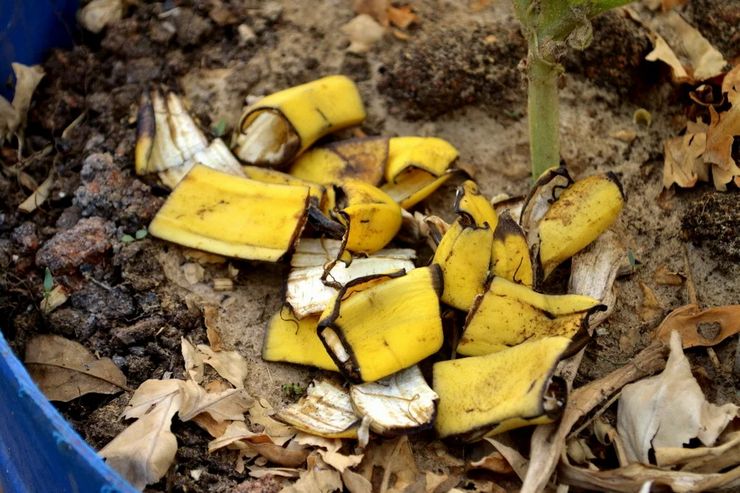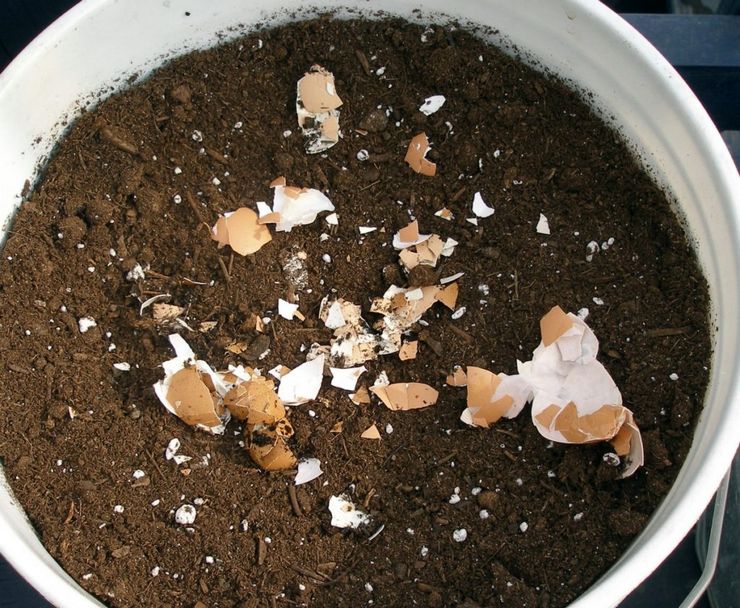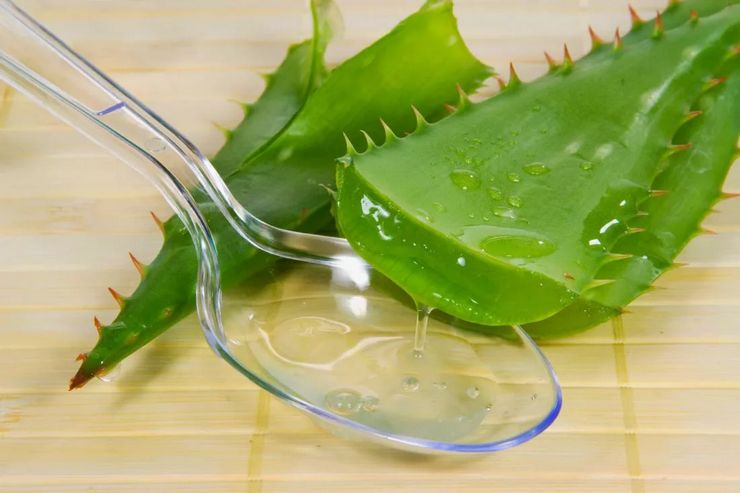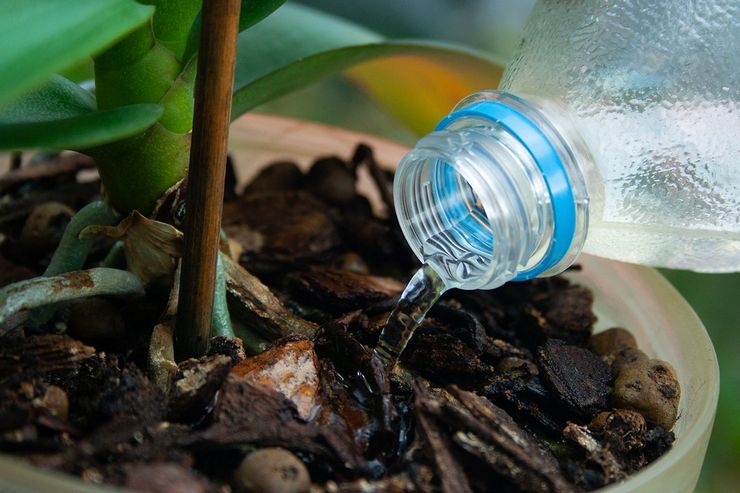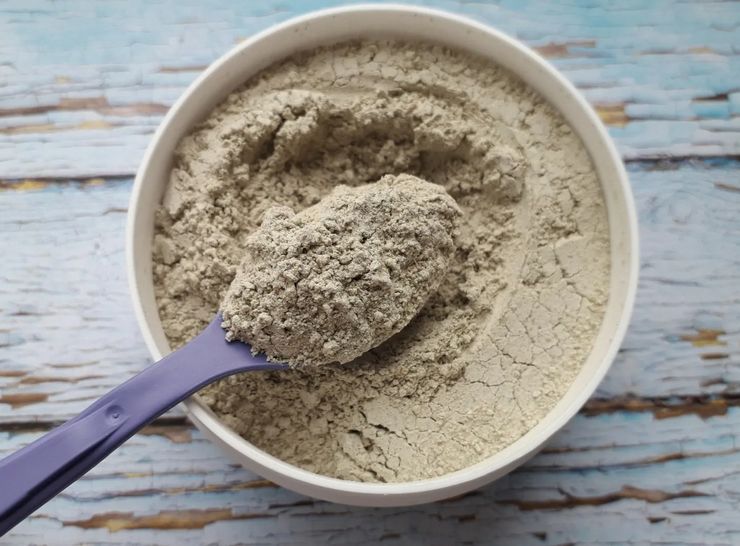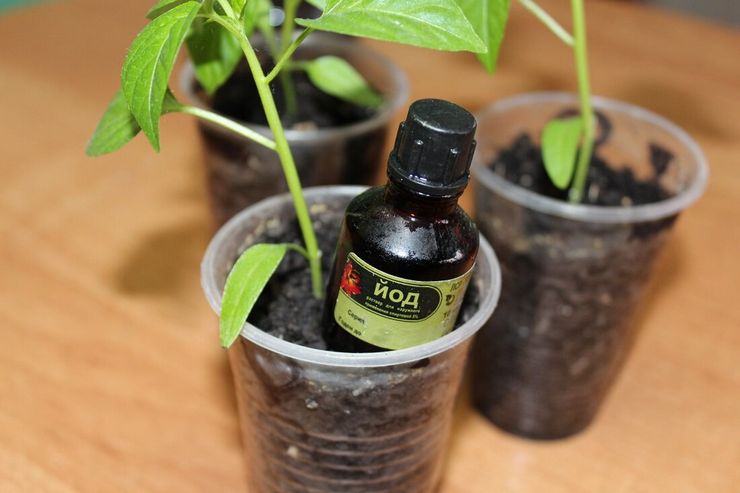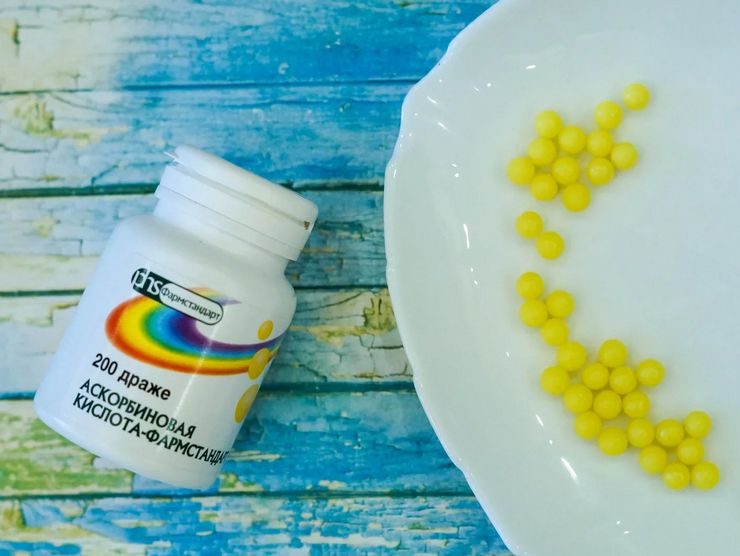Houseplants do not have the ability to draw nutrients from the environment in the same amount as ground flowers and shrubs. The soil in the pot is depleted quickly enough, therefore, for healthy growth, such crops require regular application of special fertilizing – mineral or organic. The application schedule and the choice of composition will depend on the characteristics and preferences of a particular flower..
Top dressing of indoor flowers
The correct choice of the timing of feeding and the dosage of the composition allows the plant in the pot to develop well, as well as bloom or bear fruit more luxuriantly. Most crops need to be replenished about twice a month. Lack of top dressing can have a bad effect on the growth rate and decorativeness of the flower..
In most cases, flower growers go to specialized stores for nutrients, but sometimes you can also feed the plant with improvised means bought at a grocery or in a pharmacy. Usually discarded shells, dormant tea or banana skins, as well as inexpensive but effective drugs can be used..
But you should not fertilize house plants too often. An excess of certain elements in the composition of the soil can also lead to weakening, loss of attractiveness or disease of the flower. The frequency and volume of feeding each plant, as well as the means used for this, should be selected individually, focusing on its needs, as well as on the seasonal stages of development.
THE BEST FEEDING FOR HOME FLOWERS! NUTRITIONAL COCKTAILS ON ANY WALLET!
When to feed plants
Most home flowers develop unevenly throughout the year, sometimes increasing, sometimes slowing down the growth rate. Knowing the features of each of these stages, you can choose the optimal set of nutrients for planting..
Spring
In the spring, most houseplants begin to wake up after a winter rest period. This is facilitated by an increase in the length of daylight hours. Regardless of whether the bushes fell into complete dormancy or only slowed down development, it is at this time that they begin to actively form young shoots and can lay buds. To do this, they will need a lot of energy, and this is what feeding should give. Plants begin to fertilize when they notice signs of growth. At the beginning of spring, the bushes will especially require nitrogen, which contributes to the development of the leaf mass. Before flowering, the need for nitrogen decreases; instead, potassium and phosphorus supplements should be used to stimulate the development of buds. Most often, feeding is carried out 2-3 times a month until flowering. Fertilizers are usually applied in liquid form, trying to keep the soil in the pot already moist. This will protect the planting roots from burns. For plants that do not allow waterlogging of the soil, fertilizing is often combined with watering.
Summer
Species that bloom in summer continue to be fertilized until fall. At this time, they have an increased need for potassium supplements. They are applied every couple of weeks by watering the plants or by spraying. But for bushes that are completely covered with flowers, the root method of application is preferable – the ingress of liquid fertilizers on the petals will lead to the appearance of brown spots on them, which reduce the decorative effect of the bush.
Autumn
After a lush summer bloom, plants begin to gradually slow down their growth rates. Along with this, the care schedule for such plantings should also be adjusted. They are watered and fertilized a little less often, allowing them to prepare for winter rest. At this time, it is recommended to use formulations with a predominance of phosphorus for dressing. They are applied about once a month, trying to reduce the dosage in comparison with the summer.
If the flowering period of a species falls exactly in the fall, they continue to look after it according to the summer “schedule”. You can use both conventional fertilizers and granular fertilizers, which dissolve in the soil longer and can provide plantings with nutrition for a longer period..
Winter
Reacting to the reduced daylight hours, many flowers go to rest, slowing down development or completely drying out the aerial part. In this way, they conserve nutritional resources while waiting for a more favorable time for growth. At this time, it is impossible to stimulate the growth of plantings with fertilizers – only a good rest can ensure the decorative effect of plants in the next season. In most cases, house flowers are not fed at all in winter. Watering is also reduced to a minimum, especially if the plantings were moved to a cool corner for wintering..
If the flowering period of a particular species falls precisely in the winter, the rules for caring for resting crops do not apply to it. Such flowers are fertilized with potassium-phosphorus compounds, adding them once every couple of weeks..
Home fertilizers
Experienced florists may be armed with not only purchased mineral supplements, but also food leftovers. When decomposed in the soil, they break down into substances suitable for plant nutrition. The undoubted advantage of such additives is their environmental friendliness and effectiveness. But these methods also have disadvantages..
Sugar
Sugar containing glucose and fructose is an excellent nutritional supplement for all types of plants. Glucose promotes better assimilation of soil nutrients and gives planting strength. But in order for plants to quickly absorb it, carbon dioxide is needed. Otherwise, sugar dressing will lead to mold and only add problems to the grower. The use of EM drugs will help to avoid this..
For feeding home flowers, use glucose or refined sugar bought in a pharmacy (1 tablet or 1 piece per 1 liter of water). Such feeding is carried out no more than once a month..
Yeast
The use of yeast is no less common. Such feeding supplies the plant with hormones that help to normalize the development of plant cells. In addition, yeast is rich in thiamine, auxin and B vitamins. Adding yeast to the substrate accelerates the process of converting organic additives into mineral elements, and also stimulates the development of various microorganisms that are beneficial to plants..
In terms of its properties, yeast is comparable to a complex mineral supplement. To prepare a nutrient solution in 0.5 liters of lukewarm water, add 1.5 tbsp. tablespoons of granulated sugar and 1 g of yeast. Top dressing is carried out once a month, using the composition for both flowering and decorative deciduous plantings.
Coffee grounds
You can add dormant coffee to the substrate for plants that prefer an acidic environment. The best effect is given by the use of dried coffee grounds when transplanting or planting a plant. Dense is added to the soil mixture as a baking powder, improving its drainage properties. In addition, it allows you to saturate the soil with nutrients and contributes to the development of microflora suitable for the plant..
There are potential disadvantages to using the grounds regularly. The caffeine contained in it may not activate, but inhibit the growth of plantings.
Tea brewing
In addition to sleeping coffee, you can also use tea leaves for dressing. It helps to improve the quality of the soil and becomes an additional source of nutrition for flowers. Before use, the tea leaves are also pre-dried, and then embedded in the ground or mixed with the substrate when planting or transplanting. In this case, dry brewing should be no more than a third of the total volume of the earth..
Among the crops that are especially responsive to such feeding are Saintpaulia. After brewing, they form buds more actively and bloom longer than usual. The tea leaves can also be used to mulch the topsoil in the pot. So the earth in it will dry out more slowly. The main disadvantage of using tea leaves in flower pots is the risk of mass appearance of sciarids, small flies annoying the grower.
Bread
Crackers are considered one of the unexpected means of feeding. The stale bread is cut into small pieces and allowed to air dry completely. To prepare a solution for plants, the resulting crackers are poured with warm water and the container is tightly closed, placing a load on top. They are left in this form for about a week, allowing the breadcrumbs to ferment. In addition to crackers, fresh weeds can also be added to the future solution. After the allotted time, the mixture is filtered, diluted with water 1:10 and used for irrigation no more than 2 times a month. This tool is considered universal..
Banana peel
Potassium-rich bananas can also be a plant-based source of nutrition. There are many recipes for using banana peel, but infusion is especially popular. Fresh banana peel is crushed and placed in a glass jar, and then poured with boiling water. After a day, the infusion is filtered. For watering, it is diluted with water in a 1: 3 ratio and used about twice a month..
Chopped and properly dried banana skins can also be added to the substrate. They will contribute to its loosening and will also become a source of potassium, which is especially necessary for plants in the spring-summer period to form more flowers. But before any use, the banana peel must be thoroughly washed with soap and soda water..
Citrus peel
The peel of various citrus fruits also contains a lot of vitamins. In addition to feeding, it also helps to disinfect the soil, relieving it of harmful components. To prepare citrus infusion, pour the fresh peel with boiling water and incubate for about 12 hours. After straining, the composition is used for watering or spraying foliage. Such measures can also help diseased plants, helping to destroy pathogens or driving harmful insects away from the bush..
Eggshell
Eggshells help enrich the soil with calcium and also serve as a drainage element. Best of all, such feeding will affect flowers suffering from soil acidification. To prepare an infusion for irrigation, crushed shells are placed in a jar and poured with water (1 liter of water per shell from 6 eggs). Covering the jar with gauze, it is left warm for a week. The infusion is diluted with water (1:10) and used for feeding.
Before using the shell, it is important to make sure that the plant being fed is not afraid of excess calcium in the soil..
Onion peel
Onion hulls are considered both a nutritional supplement and a way to combat harmful insects. To get a broth, add 15 g of husk to 0.5 l of water. The mixture is boiled over low heat for about 15 minutes, and then insisted for another 4 hours. After straining, the onion broth is used for watering or spraying. Suitable for all types of plants.
Potato broth
In the process of cooking boiled potatoes, a lot of useful substances remain in the water, therefore it is also used to feed plants. Potato starch becomes a good source of energy for them and stimulates the growth of the root system..
When the potato broth has cooled, it is diluted in a 1: 3 ratio. It is important that it is not salty at the same time. This feeding is especially good for species with thick and fleshy foliage..
Potato peelings can also be used for fertilization. In order not to accidentally introduce harmful bacteria into the soil with the peel, it should be crushed and dried in the oven or frozen. Cleansers are added to soil or used to create infusions.
Aloe juice
Soil treatment with aloe juice has an antimicrobial effect, stimulates plant immunity and improves their regeneration, and also promotes more active development of bushes.
Aloe bush from 4 years and older is used to obtain juice. Several sheets of paper are cut off from him, put in a bag and put into the refrigerator. Such processing increases the amount of juice. After a week, the foliage is crushed in a meat grinder and squeezed out. For watering 0.5 liters of water, 1/2 teaspoon of the resulting juice will be required. The solution is applied twice a week..
Cigarette ash
The effect of ash from cigarettes and tobacco dust is comparable to feeding with wood ash. Add half tbsp for 1 glass of water. tablespoons of ash and use the fertilizing solution 2 times a month.
Like ash, ash contains phosphorus and potassium, which are important for plants – the most important elements during the period of bud formation and subsequent flowering. In the fall, such feeding helps to strengthen the plantings before wintering. Among the plants especially responsive to this composition are such common crops as geraniums, begonias, as well as fuchsias and cyclamens..
When using cigarette ash for top dressing, it is important not to get carried away. Modern cigarettes contain many harmful additives and impregnations. Accumulating in the soil, they may not help, but, on the contrary, destroy the plants. In addition, ash reduces the acidity of the soil, so it is not suitable for crops that prefer an acidic substrate..
Aquarium water
Aquarium water also contains many useful substances for home flowers. It promotes the development of beneficial microflora, improves the overall quality of the soil and normalizes the acidity level. The nitrogen contained in such water activates the growth and development of plantings..
It is recommended to use aquarium water from early spring to mid-summer. After this period, the plant’s need for nitrogen supplementation decreases. Water is brought in no more than once a month – otherwise the soil may turn sour and turn green.
Fertilizers from the pharmacy
There are also many products available in the pharmacy that are suitable for improving the growth of home flowers. They are inexpensive, but at the same time they can have a rather powerful effect, so they will need to be used only once in a long period..
Tooth powder and paste
Tooth powder is part of a homemade root decay remedy. For 0.5 l of water add 8 tbsp. tablespoons of wood ash and the same amount of tooth powder, as well as 4 teaspoons of copper sulfate. The resulting mixture is stirred until all components are dissolved.
The diseased plant is gently undermined so as to slightly bare the roots, and then the mixture is applied to them and the adjacent stem. The treated bush is placed in a dark corner for a week and not watered. A similar procedure should help get rid of rot..
succinic acid
Succinic acid tablets or powder are sold both in pharmacies and in flower shops. This substance has a stimulating effect on planting and helps to strengthen the immune system. Most of all, plants weakened by stress or improper maintenance will need such feeding. Sometimes acid helps to revive even very sick flowers..
For healthy plants, acid will become an additional source of nutrients, as well as promote the absorption of those already contained in the soil. For irrigation, 1/2 tablet is added to 5 liters of water. The effect of such feeding can be enough for almost a year, but if necessary, the acid can be used a little more often. The main thing is not to use it during the flowering period or planting rest..
Castor oil
Castor oil contributes to the formation of a larger number of buds, therefore, for plantings blooming in summer, top dressing is carried out from early spring to mid-July..
To prepare a solution, 1/2 teaspoon of oil is added to 0.5 liters of water. Watering is carried out about once a month, but for each procedure, a fresh solution is needed, and not saved from the last time..
Iodine
In nature, iodine is a component of complex compounds and does not occur in its pure form. At the same time, it plays a significant role in the life of plants. Iodine promotes the activation of growth and splendor of flowering, and also serves as a protective barrier against certain diseases and pests.
The lack of iodine can be judged by the unhealthy pale foliage, weak flowering, as well as a strong susceptibility to various diseases. Almost all home flowers need iodine to varying degrees, so it is included in various complex mineral supplements, as well as means of preventing fungal diseases and strengthening the immunity of plantings. To prepare the solution yourself, add 1 ml of iodine to 350 ml of water. This mixture is used to disinfect seeds, and also use it for watering and foliar dressing..
My flowers and super food for all indoor plants.
Ammonia
This additive helps to supply nitrogen to the planting. The ammonia is perfectly absorbed and gives a quick effect, improving the color saturation of the foliage and increasing its size, as well as speeding up the process of bud formation. In addition, such a solution allows you to disinfect the soil..
To prepare the nutritional composition for 0.5 liters of water, take 1/2 tbsp. tablespoons of alcohol. The solution is used for irrigation.
Vitamin C
Ascorbic acid can be used for plants that prefer acidic soil, such as hydrangeas or azaleas. Regular use of acid when watering in a proportion of 1/2 tablet per 0.5 l of water will allow plantings to develop much faster.
For other plants, ascorbic acid can be added to the nutrient composition. For its preparation, 1/2 tablet of acid is added to 0.5 liters of water, as well as half a tbsp. tablespoons of dry yeast and sugar. The solution is infused for a day, and then diluted with water 1:10.
For the treatment of chlorosis, 10 tablets of acid and 5 g of ferrous sulfate are taken for 0.5 liters of water. The solution is used systematically for watering or spraying.
Potassium permanganate
Potassium permanganate contains a lot of potassium and manganese, which helps flowers develop better and bloom more abundantly, but at the same time, this composition, with frequent use, increases the acidity of the soil, therefore it is usually used for watering flowers that prefer a similar environment.
The main field of application of potassium permanganate for plants is disinfection. A solution of potassium permanganate is used for soil cultivation before planting, as well as in the treatment of flowers or the fight against harmful insects. The degree of concentration of the solution depends on the scope of its application. Due to the fact that potassium permanganate has a characteristic color, the color of the solution can vary from pale pink (weak) to dark purple (very rich). For nutritious irrigation, a pinkish solution used once a month will be sufficient..

